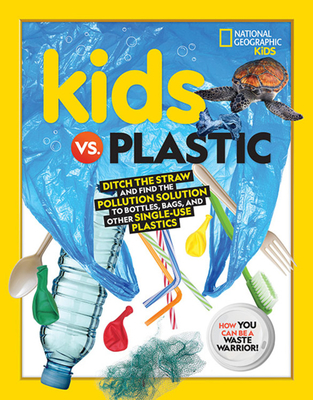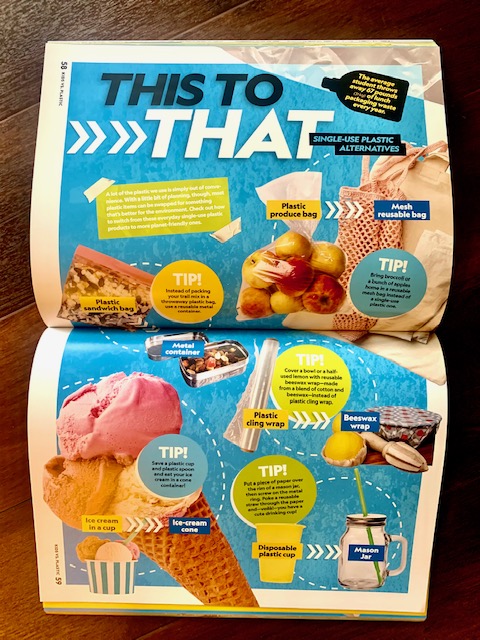
KIDS VS PLASTIC
Ditch the Straw and Find the Pollution Solution to Bottles, Bags, and Other Single-Use Plastics
By: Julie Beer
Published: December 1, 2020
Publisher: National Geographic Kids
Non-Fiction
Every year, humans are creating 448 million tons of plastic adding to the nearly 9 billion tons already accumulated in the last 70 years. National Geographic hopes that through this book, they can inspire kids to create change in their homes, their schools, and their communities. The book has seven chapters dedicated to understanding plastic and why it is so bad for our environment, how to reduce your own plastic consumption and avoid using it, how to reuse the plastic you have, and then finally how to avoid sending plastic to the landfills. The book features “Take Action” steps for kids to do right now in this fight against plastic.
I think many of us, myself included, assume that if I put plastic in the recycling bin, that it will be recycled and I’ve done my part. That may not necessarily be the case. Recycling is just one way to get a handle on the overuse of plastic, but there are many other ways including stopping the use of one-time-use plastic.
Throughout the book, everyday kids and teens are featured with their stories of how they have started programs or impacted their community through recycling or stopping the use of plastic. Their stories will inspire other kids to get programs going in their own schools and neighborhoods.
The tips for reducing your use of plastic were also good reminders for me. I have really made an effort in our own home to be more aware of the use of plastic. I make sure all plastic is clean before it is placed in recycling. I also use fewer plastic bags for lunches and use containers that I can bring home and wash. One thing that I have noticed in the last year, due to COVID, is the increase in the amount of plastic that is being used in restaurants. Individually packaged condiments and to-go containers seem to be the norm and I cringe every time I see it. Even at our sons’ colleges, the cafeterias are serving meals in plastic containers rather than plates. I just don’t understand it and it makes me think that this year, more than any other, we will contribute even more plastic into landfills than before. Even stores won’t let you use your reusable bags which is extremely frustrating for me.
One of the tips I’m going to try to do is using beeswax wrap instead of plastic cling wrap on our dishes. I don’t have to use it often, but even just small changes can make a difference. That is the whole point of this book. No single person can solve the problem of too much plastic, but if each household, business, and school looked at ways to change the way plastic is used, the efforts all accumulated together could make such a difference. What is one thing that your family could do today to add less plastic to the landfill in your area?

I loved the chapter, “Looking Ahead”, which featured ways that change is already happening, for example, selling bamboo toothbrushes, which are compostable. I bet if your family took an inventory, you would see many instances of reducing plastic use as well as others that you could improve on. Refill water bottles rather than always grabbing one from the fridge. Give experience gifts rather than toys or other items. Use crayons and colored pencils instead of markers. Not every scenario is going to work for your family, but finding one thing that you could do differently will make a difference and may just start a trend in your household or neighborhood.
To purchase a copy of KIDS VS PLASTIC, click the photo below:

Other posts you might like:
Thanks to the publisher for sending a copy of this book for the purpose of this review. This review is my honest opinion. If you choose to make a purchase through the above links, I may receive a small commission without you having to pay a cent more for your purchase.
Posted Under Book Review, Children's books, environment, Julie Beer, National Geographic, pollution
